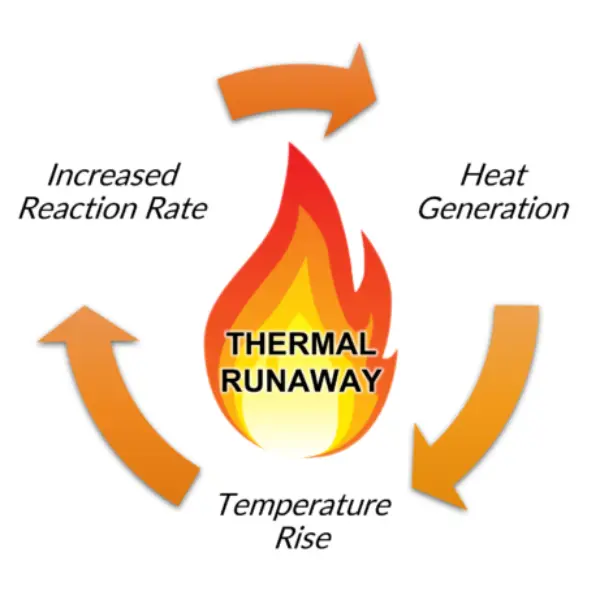
What is battery thermal runaway? This critical question lies at the heart of exploring the complexities of battery cell behavior. This article delves into this phenomenon’s causes, prevention strategies, and dangers.
Part 1. What is battery thermal runaway?
Battery thermal runaway occurs when a battery becomes excessively hot, triggering a rapid and uncontrollable increase in temperature and pressure within the cell. This heightened heat causes the internal chemical reactions to accelerate, releasing additional heat and gases. This runaway process can swiftly escalate, leading to catastrophic consequences such as explosions or fires. Factors like overcharging, physical damage, or exposure to high temperatures can initiate thermal runaway.
Once initiated, thermal runaway can propagate rapidly throughout the battery, posing significant safety hazards to nearby objects or individuals. In essence, battery thermal runaway is a critical concern in energy storage due to its potential for severe damage and danger.
Part 2. What causes thermal runaway in batteries?
External factors
- Overcharging: When a battery receives more electrical charge than it can handle, it leads to excessive heat buildup, triggering thermal runaway.
- High temperatures: Exposure to external heat sources, such as direct sunlight or hot environments, can raise the battery’s temperature to dangerous levels, initiating thermal runaway.
- Physical damage: Any damage to the battery casing, such as punctures or cracks, can expose the internal components to air and moisture, leading to short circuits and thermal runaway.
Internal factors
- Manufacturing defects: Inadequate quality control during production can result in impurities or inconsistencies in the battery materials, creating weak points prone to overheating and thermal runaway.
- Internal short circuits: Damage to the battery’s internal structure, such as the separator between positive and negative electrodes, can cause short circuits that generate excessive heat and trigger thermal runaway.
- Chemical instability: Certain battery chemistries are inherently less stable and more prone to thermal runaway. For example, lithium-ion batteries are known for their high energy density. Still, they can undergo thermal runaway if the electrolyte becomes unstable due to overcharging or exposure to high temperatures.
Part 3. How to prevent thermal runaway in batteries?
Cell Arrangement
Uniform Cell Distribution:
- Ensure that battery cells are evenly distributed within the battery pack to promote uniform heat dissipation.
- Avoid clustering cells together, creating hot spots and increasing the risk of thermal runaway.
Thermal Isolation:
- Use insulating materials between battery cells to prevent heat transfer and minimize the spread of thermal runaway.
- Insulation helps contain heat within individual cells and reduces the likelihood of cascading thermal events.
Venting And Cooling Accessories
Pressure Relief Mechanisms:
- Install pressure relief valves or vents in battery enclosures to release excess gases during thermal runaway.
- These mechanisms prevent internal pressure buildup, reducing the risk of explosions.
Heat Dissipation Components:
- Incorporate heat sinks or spreaders into battery packs to dissipate heat more efficiently.
- Heat sinks absorb and transfer heat away from battery cells, preventing overheating.
Ventilation
Effective Airflow Design:
- Design battery enclosures with adequate airflow channels to promote natural convection cooling.
- Ensure air can flow freely around battery cells to dissipate heat and maintain optimal operating temperatures.
Forced Air Cooling:
- Implement fans or blowers to circulate air within battery enclosures and enhance cooling.
- Forced air cooling systems can help regulate temperature and prevent thermal runaway in high-demand applications.
Battery Management Systems (BMS)
Temperature Monitoring:
- Utilize BMS to monitor the temperature of individual battery cells continuously.
- BMS sensors detect overheating and trigger protective measures to prevent thermal runaway.
Voltage Regulation:
- Implement voltage regulation features in BMS to prevent overcharging and undercharging battery cells.
- Maintaining optimal voltage levels reduces the risk of thermal runaway caused by excessive charging or discharging.
Thermal Management Strategies:
- Employ BMS-controlled cooling systems to manage the temperature within battery packs actively.
- BMS can adjust cooling fan speed or activate liquid cooling systems to maintain safe operating temperatures and prevent thermal runaway.
Part 4. The dangers of thermal runaway batteries
Thermal Events
Temperature Rise
- Thermal runaway begins with increased temperature within the battery cell, typically due to overcharging, physical damage, or exposure to high temperatures.
- As the temperature rises, it accelerates the chemical reactions within the battery, leading to a further increase in temperature.
Gas Evolution
- The elevated temperature causes the electrolyte in the battery to decompose, releasing gases such as hydrogen, oxygen, and carbon dioxide.
- These gases increase the battery’s internal pressure, further exacerbating the thermal runaway process.
Cell Rupture
- Eventually, the pressure buildup inside the battery becomes too high, causing the cell to rupture.
- This rupture releases hot gases and electrolytes, potentially igniting nearby materials and leading to fires or explosions.
Safety Implications
Consumer Electronics
- Thermal runaway batteries in consumer electronics like smartphones and laptops can pose a fire hazard, endangering users and causing property damage.
- Safety features like thermal cutoff switches may mitigate risks, but users should be vigilant and follow manufacturer guidelines.
Electric Vehicles (EVs)
- Thermal runaway in EV batteries can lead to fires or explosions, endangering occupants and causing vehicle damage.
- Advanced battery management systems (BMS) and thermal monitoring technologies are critical for detecting and preventing thermal runaway in EVs.
Energy Storage Systems (ESS)
- In large-scale energy storage systems, thermal runaway can result in significant property damage, environmental contamination, and economic losses.
- Stringent safety regulations and regular maintenance are essential to minimize the risk of thermal runaway in ESS installations.
Regulatory Standards
- Regulatory bodies impose standards and regulations to ensure the safety of battery-powered devices and systems.
- Compliance with these standards and rigorous testing and certification processes helps mitigate the risks associated with thermal runaway.
Part 5. FAQs
-
What causes thermal runaway in lead acid batteries?
Thermal runaway in lead acid batteries can be caused by overcharging or excessive heat. -
Which types of batteries are susceptible to thermal runaway?
Lithium-ion and lithium-polymer batteries are susceptible to thermal runaway due to their chemistry and design. -
How do you prevent thermal runaway in lithium-ion batteries?
Thermal runaway in lithium-ion batteries can be prevented using protective circuitry, proper charging techniques, and avoiding physical damage.
Related Tags:
More Articles

Battery Load Test: A Comprehensive Guide
Step-by-step battery load test guide for car, solar & industrial use. Learn how to load test a battery, interpret voltage charts, and avoid common mistakes.
The Comprehensive Guide to Battery Balancing and Battery Balancer
Discover how battery balancers improve lithium battery performance, lifespan, and safety. Learn types, functions, and tips to choose the right balancer.
What Is the Best Voltage for a Chainsaw Battery?
Compare 12V-80V chainsaw batteries for light pruning, medium firewood, and professional cutting. See best battery chainsaw with runtime charts and safety tips.
Lithium VS. Alkaline Batteries: A Comprehensive Comparison
Lithium batteries last 3–7× longer than alkaline and perform better in cold weather. Compare lifespan, cost, safety, and best uses to choose the right battery.
Comparing Lithium-Sulfur and Lithium-Ion Batteries: Which is Right for You?
Compare lithium-sulfur (Li-S) and lithium-ion batteries on energy, lifespan, cost, safety, and applications. Best choice for drones, EVs, and electronics.



